by Wanda Sabir
Happy Spring Season … Happy Jazz Appreciation Month, National Library Week, Poetry Month.
‘Tales of the Grim Sleeper’ on serial murders in South LA over 25 years, 250 Black women missing – a review
Over a 25 year period, 200 women in South LA went missing. Of these missing women, 100 were found dead. All of the women are Black and most were prostitutes. Several women escaped capture or survived the assault, yet the police never interviewed these survivors or followed up 911 calls. The residents were not notified of the serial murders in their midst, and so everyone was at risk. Lonnie Franklin Jr. was arrested for the crime in July 2010, yet five years after his arrest, the trial has not been set.
The refusal to let these women’s lives go unacknowledged is due to the work of Black Coalition Fighting Back Against Serial Murders, which since the mid-1980s has worked to get information out about the murders, campaigned for justice and protested “the criminal neglect by law enforcement in the investigation of the murders.”

Founder Margaret Prescod was in Oakland for a preview screening before the HBO broadcast April 27 of “Tales of the Grim Sleeper” to talk about the missing and murdered women, a push for the trial, and the placing of a monument to the lives of these women. See http://www.hbo.com/documentaries/tales-of-the-grim-sleeper#/.
Why were these women’s lives taken, yet law enforcement did not pursue their killer(s)? One woman says the fact that they were prostitutes erased the victims’ humanity. The attitude of law enforcement and LA county city government was that whoever was killing the women was clearing the streets – killing Black women was doing the state a favor.
So, who cares how many gone, how many are in danger or at risk? Who cares that Franklin is getting older and so are family members of the victims who have been advocating and rattling the doors of City Hall for justice?
Pam, the star of the film, says the reason for the apathy is that the victims were Black women. No one cares when a Black woman is raped, mutilated or killed.
Pam risks her sobriety by taking the filmmaker and cinematographer to locations where she once got high and turned tricks. Her heroism captured on camera, shapes the compelling story of poverty, exploitation and blatant government negligence. As viewers hear one story after another and meet the mothers and sisters and friends of the disappeared , murdered and escapees, and then witness how sloppily the case has been handled since 2010 going back to 1990 – by 9/11 dispatch, detectives, the county district attorney’s office and other law enforcement, including mayors during these two decades – this decimation against women based on pigment just shows how far we have yet to go to rid this nation of the disease of white supremacy and racial dominance.
This disease is coupled with what bell hooks calls a “phallocentric patriarchal state.” “Utterly disenfranchised in almost every arena of life in the United States, (the Black men who support it) often find that the assertion of sexist domination is their only expressive access to the patriarchal power they are told all men should possess as their gendered birthright. … [I]t should not surprise or shock that many Black men support and celebrate ‘rape culture’” (“Outlaw Culture” 128-129).
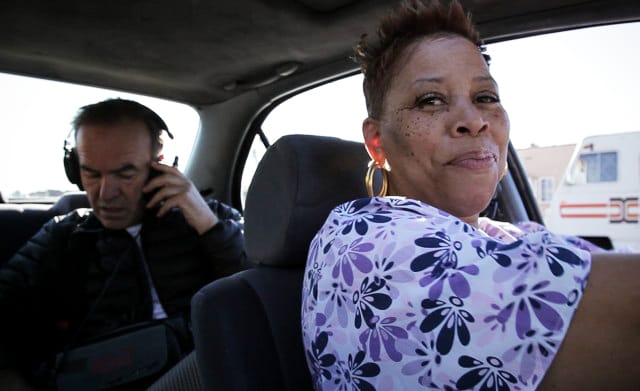
The politics of Franklin’s conviction were completely absent from British director Nick Broomfield’s story. One person who attended the screening said Franklin was convicted by film. There were aspects of Franklin’s apprehension and booking that looked like an auction block – his body a commodity, measured and weighed for service. However, the film does not spare any sympathy for the perpetrator or the potential death penalty his conviction might raise. This is not his story. If anyone is looking for sympathy or compassion for Franklin, this is not the film. If any potential jury member watched the film, its blatant indictment of Franklin would be cause for excusing themselves. Even though his DNA was found on several of the women’s bodies, the conclusion was that one man probably did not kill 200 women, so the hunt should not stop.
Pam, former prostitute and recovering addict, helps the director track down Franklin’s former dates, co-workers and neighbors. She gives him the insider tour, yet is not in the synopsis. Without her help, this film would have not been made. Pam knew these women; they spoke to the directors because Pam set it up. Her presence cosigned the conversation. Before they met Pam, the Black people in the South LA community where the serial murders took place were suspicious of two white men in their neighborhood asking questions.
I hope they paid her well for her insight and help. She was unemployed because of a nonviolent third strike.
What I appreciated though were the women whose lives were erased and how this film honors them. Lonnie’s arrest, the DNA, his anger at his former wife … Well, we will see how all this gets worked out. It is certainly bigger than the man behind bars. I thought it sad when his son said he lost his best friend. See http://nickbroomfield.com/Tales-of-the-Grim-Sleeper-1.
Xtigone, Antigone, Antigonik in Bay Area theatres
For some reason “Antigone,” Sophocles’s work which features a female character who not only doesn’t follow the trajectory of her assigned role, she rebels against the state and suffers for it, is having a resurgence in the San Francisco Bay Area with three very different productions at African American Shakes, Cuttingball and Shotgun theatres February-April.
Traditionally, Antigone is killed; however, in Nambi E. Kelley’s work, Xtigone lives and the dead are not buried; beginning with her brother, they are unburied. It is provocative and daring – the idea of a citizen going against the prescribed order. President Obama said as much in his speech on the anniversary of Bloody Sunday in Selma. The All of Us or None contingent that went to Alabama saw that there is much left to do before America can bury her dead.
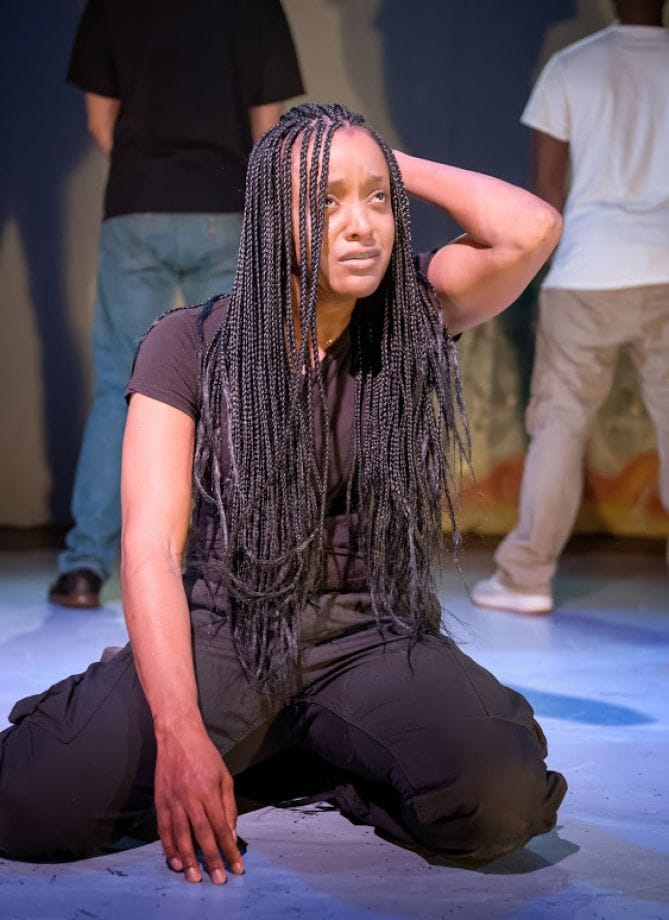
I attended the play that historic weekend in San Francisco. The second major work in African American Shakespeare Company’s 25th Season, “Xtigone,” playwright Nambi E. Kelley’s treatment or reimagining of Sophocles’s “Antigone,” raises issues not easily ignored on International Women’s Day 2015 and the 50th Anniversary weekend of Bloody Sunday in Selma, Alabama. Set in Chicago, the First Family’s hometown, Lorraine Hansberry’s literal stomping ground along with notables: Ms. Gwendolyn Brooks, The Art Ensemble, the AACM and so many more – DuSable, anyone (smile), Black Classics Press, the Hon. Elijah Muhammad’s Nation of Islam, Nobel Drew Ali’s Moorish Science Temple … Dr. Jeremiah Wright’s Black Prophetic Justice, Richard Wright, a Native Son.
Chicago is also one of America’s most bloody cities. It rains red there. Remember the child who marched in the inaugural parade two years ago who was killed just a week later? She survived DC, but not Chi Town.
In the classic story, Antigone wants to bury her brother and when she disobeys her uncle, she is killed. In Kelley’s tale, Tig unburies the dead, because she believes the killing will not stop until the cover-up ceases. It is a time of war, then and now. In actress Ryan Nicole Austin’s able hands, Tig takes on her Uncle Marcellus (Dwight Dean Mahabir), who is also city mayor, and her Aunt Fay (Jasmine Strange). Even her sister Izzy (Tavia Percia) does not support her sister’s challenge.
All alone except for Mama Goddess, Tigs feels compelled – driven to complete the work her brother E-Mem started. The Disciples gang leader (actor AeJay Mitchell) was trying to uncover the source of the weapons in his community and the trail was leading him to City Hall. As E-Mem called his uncle out, he simultaneously placed the blame for the deaths in the leader’s hands. Tigs not only unburied E-Mem, after Uncle Marcellus performs the rites, she has everyone in Chicago’s effected communities bring their dead to City Hall too. There are bodies everywhere – one could reach out, just lean forward a bit (from front row theatre seats) to touch a corpse.
Yes, it got a bit creepy, but that was the (unstated) intent. Gun violence is epidemic in Chicago and other American cities. It is an illness, a social infection worse than AIDS. The dead cannot rest; AeJay Mitchell’s E-mem and to a lesser degree, rival gang leader, Drew Watkins’s Ernesto is similarly disturbed. Who killed them before peace was secured? E-mem haunts his city; he talks to his sister, appears to his uncle. He will not lie still; his commitment is cut short, but with Tigs he has a chance to continue. Tigs inherits her dead sibling, E-Mem’s work. In Dagara or West African culture, it is expected when a young person dies that the living siblings celebrate his life. E-mem leaves so much unfinished for Tigs, who in turn leads a double life.
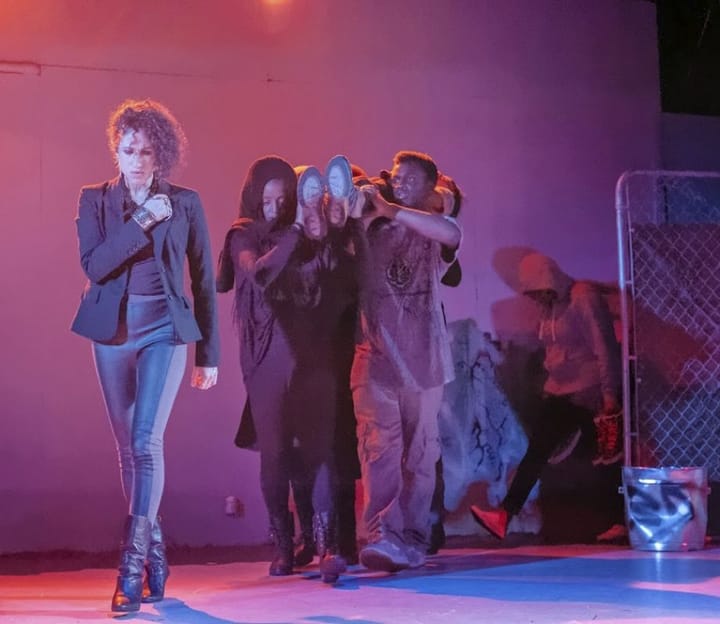
Eventually the dead sibling relieves the living person of such responsibility, but only after the earthly tasks are done. AeJay Mitchell’s character is a driving presence in Tigs’s life. He is always on stage – he is not a passive ghost. There is too much at stake and he knows this, even if Tigs does not initially. The work E-Mem, then Tigs do, mirrors that of Dr. Joe Marshall at Alive and Free in San Francisco. E-Mem’s and fellow gang leader Ernesto’s collective goal is thwarted in a town where the mayor’s wife is selling souls for cash.
How can a truce keep citizens alive and free when body counts equal wealth? The Latin Kings and Disciples leadership truce only temporarily interrupts, yet does not stop, the war machine. They do not operate the machine which prints money on the backs of its most vulnerable citizens. Fay is so deep in the game we see dirt raining on the two, Chicago’s first lady and her unsuspecting husband. She sells her soul without reading the fine print. Faye’s temporary fame ends tragically when she opens the attaché case for everyone to see the corpses, dead bodies (skulls, amputated hands … blood money). Chicago’s guns and its violence are interchangeable with African conflict diamonds. The enemy keeps us fighting worldwide so it can take the spoils.
Dirt rains on Marsellus as Faye screams.
There are so many guns on stage, so many dead walking or about-to-be-dead children walking that the heaviness of the work rivets a person to her seat. I know the first time I saw the play, there was no intermission and I could barely move when the curtain fell. The added intermission, while powerful, weakened Xtigone’s intensity.
The potency dissipates, like a cloud pregnant with rain evaporates in the sunshine. I am not sure if that is a good thing. Did I miss the showers? Was I happy to leave damp, yet dry? Are we let off the hook? Some patrons used the intermission as an opportunity to escape. Not everyone came back I noticed as I moved closer to the burying ground. I wish the performance had ended with a conversation about next steps. Do we take our dead to city hall in San Francisco, Oakland, Richmond, San Leandro …? What do we do with our loved ones chilling on cooling boards still too warm to touch?
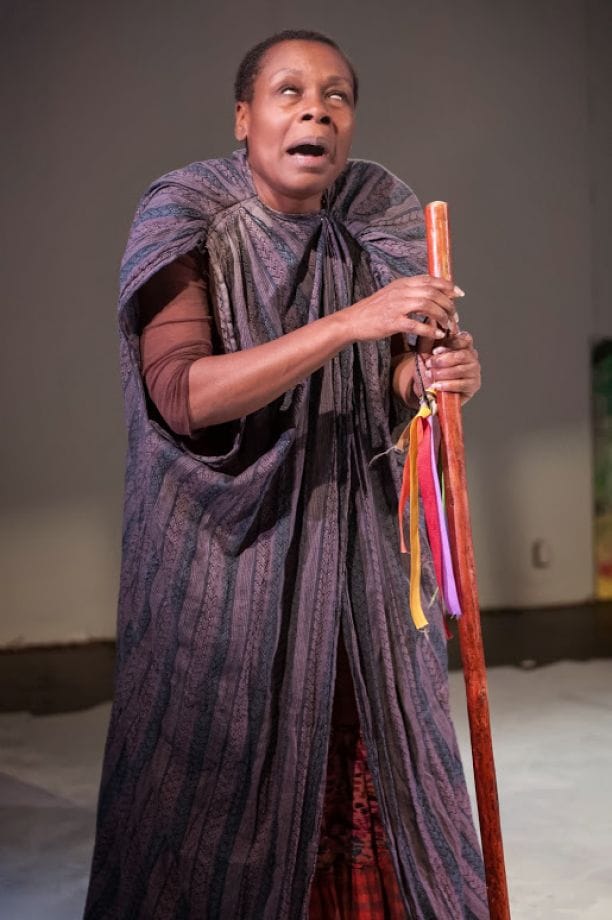
The talented young cast sing, dance and use sign-language in this well-choreographed and directed work. Coarse street vernacular characterizes most of the dialogue; even the Old Seer (Awele Makeba) uses profanity which I think is unnecessary, yet despite this criticism, Kelley’s reworking of Antigone in Xtigone, a play which revolves around a curse – her father Oedipus sleeps with his mother. Tigs decides to uncover this degradation of all that is holy and human. She uses her legacy as a warning. How easily honor turns to horror. She unburies the dead to give these ancient roots a repotting.
Ms. Rhodessa Jones is a perfect choice as director; her ability to spin tales and weave magical realism on stage is legendary. Her Medea Project: Theatre for Incarcerated Women is testament to her vision. Incarceration is relative. “Xtigone” is the story of a city under siege, a city at war. Isn’t war the ultimate captivity, that and the fear war brings? Ancestors get up and walk among us – they are in the aisles, behind us in the darker regions of the inarticulate shadowy spaces. The ghosts’ random wanderlust remains one of the works more unsettling aspects.
For those familiar with Jones’s aesthetic hand, we notice the use of ASL and the work’s heighted feminine. Even if the words were not spoken, that is, “Mama Goddess,” we would know SHE was running this show (smile).
Ms. Jones in collaboration with Tommy “DJ Soulati” Shepard pull together an amazing work – Jones says Shepard was with her in rehearsals composing melodies to fit the scenes. Known for his ability to craft scores, especially in hip hop theatre, “Xtigone” is in keeping with his reputation. Kelley’s play would have been wonderful without the music; her stunning lyricism coupled with Shepard’s craft make the work a contemporary masterpiece. Again, it is because the cast are such fine artists: Tigs’s sister Izzy (Tavia Percia), not to mention the Chorus (Brooklyn Fields), Fay (Jasmine Strange) and Tea Flake (Naima Shalhoub). When the two gangs square off, Michael Wayne Turner (Tigs’s beau) is paired with a wonderful younger gangster who holds his own with the older actor.
Places of resonance are when the cast surround the mayor and make him face the deaths. The contemporary ring shout holds the dead. The youth call the names of children killed by gunfire and sanctify the ground where they lie uncovered. The mayor runs from its center, but there is nowhere for him to go. While he babbles incoherently at the intersection between worlds, it is the vocalese of mayoral aide Niama Shalhoub’s Tea Flake that keeps us falling off the edges of our seats. Tea Flake opens the work; she is the voice we can trust. And we follow it even when Tigs is arrested; Fay admits to graft and selling out and Beau arrives too late (or so we think) – Tea Cake keeps the story moving from one frame to the next. Often a lone voice in the quiet or disquiet, Tea Flake is also conflicted; she likes and perhaps admires Tigs, but who would go against a power structure like the mayor and his City Hall unless she wants to suffer the same fate as her brother E-Mem?
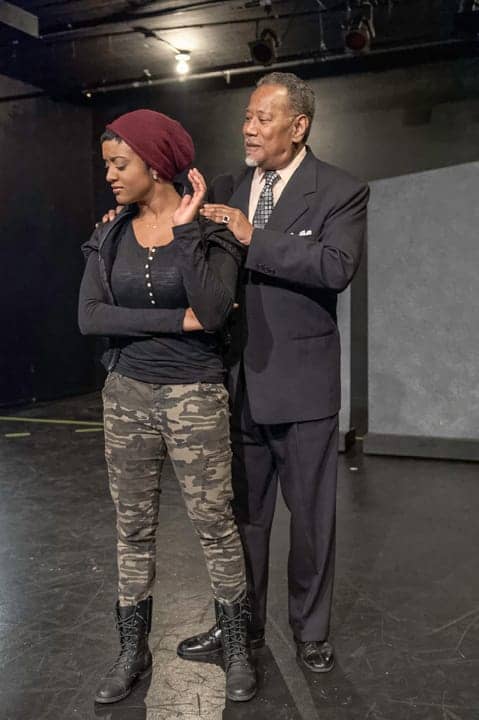
Tigs is alone; even her fiancé, Beau (Michael Wayne Turner) cannot save her from the gallows. There is a lovely scene where Tigs sings of her doubt and fate. Human walls confine her – pliant, they push back when she tries to escape. Tigs never forgets where she is going or where she came from. She is connected to a linage bigger than the sins of her father and mother. Several times we hear her call the names of her ancestors and heroines whom she gains inspiration. A name she calls is that of first lady, Mrs. Michelle Obama. The goddess who lives in Tigs’s world is engaged, active and present. She is a Mama Goddess, who blesses all her children, yet seems to favor the women (smile).
Awele Makeba, as the old woman, dances the medicine, while the old seer chastises the mayor who “should have known better,” she says. He once was a man with principles we learn in a talk with his son, Beau (Michael Wayne Turner), who implores his father to return to these core beliefs before it is too late. Dressed in ceremonial white, Makeba whirls and bends the space between subjects as she sweeps the temporal with magical broom, tying off loose threads which occasionally entangle. She welcomes the departed and clears the path for the living. We hear her rattle – like cowries sending telegrams between saints and those left unearthed. The rattle is also Dhambalah, the snake, purifying the sacred spaces which contain both suffering and healing. Makeba’s Spirit, like the seer, mediates between slumber and death.
Tigs can see the dead too. She and her brother E-Mem have a special relationship. Sometimes one cannot outrun destiny.
“Xtigone” is cautionary, while at the same time it honors the young lives lost to senseless violence. The two gangs: Disciples and Latin Kings want to halt the violence, but who will be the first to put down his gun? In this contemporary world, young girls carry assault weapons as do boys. Bravado leads to unnecessary killing and death, surprising in its random trajectory. “Xtigone” is powerful, because we know these children and the names called. The bodies unearthed belong to our kin. Two are my nephews, Carlton and Oba – one killed in San Francisco, the other in Oakland. I wonder what happened to their shoes? Perhaps if killers or those responsible for the death of so many innocents had to walk in the shoes of their victims, the landscape might take on a different meaning? To his credit, Marsellus puts on E-Mem’s Jordans.
Dwight Dean Mahabir’s character, to his credit (and Kelley’s writing) does not remain in a weakened state. Just his associations with the Seer or Old Woman, whom he initially listens to early on in his career, gives citizens – and the audience – a bit of hope. But until the very end, we don’t know which way his spirit will blow – lovely Fay (Jasmine Strange) his windy city.
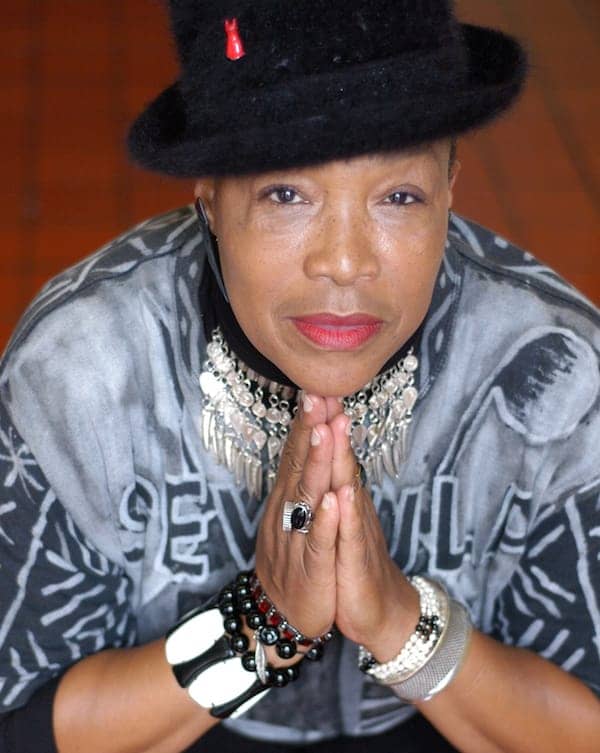
From the set to the costumes and lighting, “Xtigone” had a fabulous world premiere in San Francisco at the African American Shakespeare Theatre, celebrating 20 years this 2015 (smile). Look out, Chicago, the next stop on the tour. African Shakes’ production will be a hard act to follow (smile).
Brava, Cultural Odyssey and Planned Parenthood present ‘Birthright?’
In celebration of The Medea Project: Theater for Incarcerated Women’s 25th anniversary, Brava! For Women in the Arts and Cultural Odyssey present “Birthright?” a collaboration between Cultural Odyssey and Planned Parenthood Northern California. All performances will be at Brava Theater Center, 2781 24th St. at York, San Francisco, running Thursdays through Sundays, April 9-19. All shows Thursday through Saturday are at 8 p.m. with matinees on Sunday at 3 p.m., with a Special Gala Show Saturday, April 11. Tickets are $20-$50. Discount ticketing: students and seniors $5 off ticket price, children under 10 $10 for all shows, 10 percent discount for groups of 10 or more. For information and tickets, call 415-641-7657 and/or log on to http://www.brava.org.
Free Conference and Film Festival at Harvard University
African and Diasporic Religious Studies Association presents “African and Diasporic Spiritual Soundscapes” at Harvard University, CGIS South Building, 8-5, Friday, April 3, http://www.adrsa.org/conference.php, with special guest WolfHawkJaguar, award-winning filmmaker, musician, actor and activist, with keynote address by Wande Abimbola, professor emeritus of African languages and literatures and Awise Awo Ni Agbaye, spokesperson for the Ifa religion throughout the world, opening plenary by Kokahvah Zauditu-Selassie, professor of English and author of African Religious Traditions in the Works of Toni Morrison. Day 2, Saturday, April 4, 11-4, features an African and Diasporic Religions Film Festival featuring “Sacred Journeys: Osun-Osogbo” (WGBH/PBS), “Search for the Everlasting Coconut Tree” (Adimu Madyun), “The Summer of Gods” (Eliciana Nascimento).
Destiny Arts presents ‘Warrior’
“Warrior” is a full-length work featuring a cast of 45 talented youth ages 9 to 18 who perform a scintillating combination of hip-hop, modern and aerial dance, theater, spoken word, rap and song, accompanied by powerful video backdrop art. This year’s 22nd annual production is based on the six principles of Destiny’s Warrior’s Code: love, respect, care, responsibility, honor and peace. Each principle is personified as a peaceful warrior. Each warrior has an enemy: hate, disrespect, neglect, apathy, shame and violence.
The show takes place in a video game called Warrior, where the goal of the game is for the warriors to defeat their enemies by any means necessary – or so it seems at first. The warriors are lured into the pitfalls of romantic love, the distraction and obsession of social media, the horrors of racism and racial profiling, and the promise that violence can bring peace. There is the wild and terrible character of MisEducation, who uses every opportunity she can to throw a wrench in the warriors’ quest.

“Warrior” is limited to just six sell-out performances Friday, April 3, and Saturday, April 4, at 7:30 p.m. and Friday, April 10, at 7:30 p.m. and Saturday, April 11, at 2:00 p.m. and 7:30 p.m., and Sunday, April 12, at 5 p.m. at the Odell Johnson Theater at Laney College, 900 Fallon St., Oakland 94607.
Tickets for “Warrior” are priced $13-$30 sliding scale for adults ($20 suggested) and $7 for youth 18 and under and may be purchased through Destiny Arts Center at www.destinyarts.org or 510-597-1619 x100. Group rates are available. The theater is wheelchair accessible.
Eddie Gayle celebrates Jazz Appreciation Month
First AME Zion Church – 150 Years in San Jose – presents curator Clarissa Moore’s African American Journey Exhibit and Eddie Gale and his Spiritual Jazz Unit, Sunday, April 12, Jazz Appreciation Month, 3-5 p.m. Doors open at 2 p.m. A $35 donation is requested for food, which includes Sandi’s Cobbler Cups. First AME Zion Church is located at 95 South 20th St., San Jose, CA 95116
Promised Land: Jacob Lawrence at the Cantor
A gift from the Kayden family, “Promised Land” will be on view April 1-Aug. 3, 2015, at the Cantor Arts Center, Stanford University. This exhibition presents 56 works by Jacob Lawrence (1917–2000), the most widely acclaimed African American painter of the 20th century, and one by his spouse, Gwendolyn Knight (1913–2005). The paintings, drawings, prints and illustrated book, made between 1943 and 1998, illustrate the depth and breadth of Lawrence’s work and explore the themes for which he is famous: African American history, the Black experience in 20th-century America, urban life, modern labor and the artistic journey.
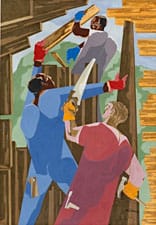
This tremendous gift from the Kayden family is one of the largest Jacob Lawrence collections in any museum. “Promised Land” presents the works together for the first time. A fully illustrated publication, with essays by eight Stanford faculty members, accompanies the exhibition.
On Thursday, April 23, 5:30 p.m. in Cantor Auditorium, Stanford faculty members discuss selected works from the exhibition, illuminating the social and political contexts for Jacob Lawrence’s iconography and exploring the artist’s significance to American art. The panelists are Michele Elam, Professor of English and Olivier Nomellini, Family University Fellow in Undergraduate Education, Department of English; and James T. Campbell, Edgar E. Robinson Professor in United States History, Department of History.
“Pool Parlors and Beat Cops: The Colorful Noise of a Jacob Lawrence Street Scene” is Thursday, May 7, 6:30 p.m., Cantor Auditorium. Nate Sloan, Geballe Dissertation Prize Fellow at the Stanford Humanities Center, connects music of the Harlem Renaissance with the art of Jacob Lawrence.
Admission is free at the Cantor Arts Center at Stanford University. The Cantor is open six days a week: Wednesday-Monday, 11 a.m.-5 p.m., plus Thursday until 8 p.m., but closed on Tuesday. It’s located on the Stanford campus, off Palm Drive at Lomita Drive and Museum Way. Weekday parking is $2 per hour. Cantor information: museum.stanford.edu.
Art exhibition: ‘Who Is Oakland?’
“Who is Oakland?” features 10 Oakland-based artists, among them Kim Anno, Jesse Crimes, Susan Felter, Jose Garcia, Chris Johnson, John McCoy, Adia Millet, Favianna Rodriguez, Chris Treggiari and Tommy Wong. The artists respond to the City’s opportunities, challenges and aspirations.
The Oakland Museum of California (OMCA) presents a new exhibition in the spring of 2015 exploring what’s happening in Oakland today through the work of artists who live and work here and love the city. Organized by artist and visionary Chris Johnson in partnership with OMCA Curator of Public Practice Evelyn Orantes, “Who is Oakland?” will be on view from April 11 through July 12, 2015, in OMCA’s Gallery of California Art.
The Oakland Museum of California (OMCA) is at 1000 Oak St., at 10th Street, in Oakland. For more information, visit museumca.org.
11th Annual CubaCaribe Festival of Dance and Music: ‘In Search of Soul’
The acclaimed annual folkloric and contemporary dance and music festival CubaCaribe will feature three exuberant weeks of Caribbean dance and music performances, master classes, film screenings, lectures and celebrations throughout the Bay Area. Visit http://www.cubacaribe.org/festival11/program.html.
Week 1, April 10-12, African Souls: Cuba and Brasil features Abadá Capoeira San Francisco, Aguas Dance Company, Alayo Dance Company, Arenas Dance Company, Teatro Brasileiro de Dança and the Bahia in Oakland at ODC Theater, 3153 17th St., San Francisco, Friday-Saturday 8 p.m., Sunday 7 p.m. Tickets are $25 online, $28 at the door at www.odcdance.org.
Week 2, April 17-19, Soul Caribe featuring Aguacero, Alafia Dance Ensemble, Bravisimo Youth Ensemble, Colombian Soul, Cunamacué, Dimensions Dance Theater, La Mezcla, Grupo Experimental Nago at Dance Mission Theater, 3316 24th St., San Francisco, Friday-Saturday 8 p.m., Sunday 7 p.m. Tickets are $22 online, $24 at the door at www.brownpapertickets.com.

Week 3, April 24-26, Alma featuring Alayo Dance Company, Dance Brigade, Duniya Dance Ensemble at Laney College Theater, 900 Fallon St., Oakland, Friday-Saturday 8 p.m. Tickets are $25 online, $28 at the door at www.brownpapertickets.com.
CubaCaribe special events
April 9: Festival Opening Reception 6-7 p.m. Film screening: “Dancing with the Drum,” directed by Ashley James, produced by Roberta Singer 7-9 p.m. at the Museum of the African Diaspora, 685 Mission St., San Francisco, $10 in advance, $12 at the door.
April 12: Batey Boricua. Celebrate life through Puerto Rican Bomba, Plena music and dance at a community jam session. This is a family event, 4-7 p.m. at La Peña Cultural Center, 3105 Shattuck Ave., Berkeley, $5 suggested donation.
April 16: Umi Vaughan Lecture: De Curros a Especuladores: Black to the Future in Cuba, 7-9 p.m., Museum of the African Diaspora, 685 Mission St., San Francisco, $10 in advance, $12 at the door.
April 19: Dance Workshop: Guede/Papa Guede or Gaga/Rarra co-taught by Collete Eloi (Guede of Haiti) and Cheo Rojas (Papa Guede of Cuba), 3:30-5:00 p.m., Dance Mission Theater, 3316 24th St., San Francisco, $14 in advance, $18 at the door.
Volunteers needed – interested? Email info@cubacaribe.org.
Tarell Alvin McCraney is back
MacArthur Genius Tarell Alvin McCraney is back for the West Coast premiere of “Head of Passes” at Berkeley Rep, April 17-May 24, and the next month is the Bay Area premiere of “Choir Boy” at Marin Theatre Company, June 4-28. “Head of Passes,” a poignant and poetic story about the journey of family and faith, trial and tribulation. The play explores personal faith and how we use it as an aperture or guide to try and understand the many sometimes fraught, sometimes beautiful, often chaotic events of our lives.
Set in the distant present at the mouth of the shifting Mississippi River, Shelah’s family and friends plan a surprise birthday party for her. But the festivities are quickly overshadowed by a series of revelations that point to a dark secret in the family’s past – revelations that leave Shelah trying to find faith, a footing and a truer sense of God. Told in Tarell’s signature style, the play features a vast and bustling landscape, where the spiritual world mingles freely with the day-to-day.
You might remember Tarell’s loose trilogy, “The Brothers Size,” “In the Red and Brown Water” and “Marcus; Or the Secret of Sweet.”
Bay View Arts Editor Wanda Sabir can be reached at wanda@wandaspicks.com. Visit her website at www.wandaspicks.com throughout the month for updates to Wanda’s Picks, her blog, photos and Wanda’s Picks Radio. Her shows are streamed live Wednesdays at 7 a.m. and Fridays at 8 a.m., can be heard by phone at 347-237-4610 and are archived at http://www.blogtalkradio.com/wandas-picks.





